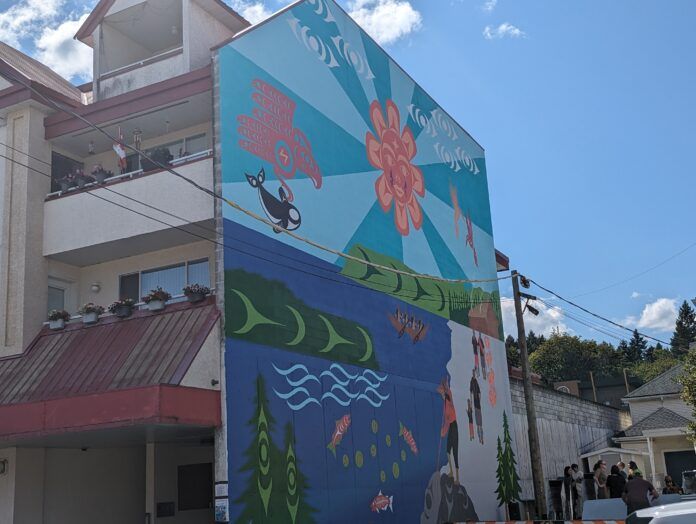A new mural has been unveiled in downtown Duncan as the next step in the area’s process of reconciliation.
The sizable piece of artwork catches the eye from Jubliee Street, adorning the building that neighbours the Duncan United Church. Its combination of bold colours may induce a gaze of wonder, but behind the spectacle is a purpose.
“It’s about showing our history. It’s about showing our pain. It’s about reconciliation,” says Cowichan Tribes’ elder Lucy Thomas. “We want this community to work together, to think alike, and be respectful of our history.”
The idea for a mural was sparked through a committee formed by a plethora of community partners, including Cowichan Tribes, the Cowichan Intercultural Society (CIS), and the City of Duncan.
Mayor Michelle Staples says that finding the large, empty canvas was a collaborative process with Cowichan Tribes elders.
“The elders wanted to walk around and see where the stories could be shown and shared. So we walked around downtown together,” says Staples. “This was one of the biggest walls, it was a big grey wall before, and this was the one that they wanted to start with to tell and share the story with the community.”
Thomas says the three-storey mural tells far more than only three stories. She shares how the sun is marked with teardrops to show the pain of their people. How the orange footprints represent the multitude of children discovered in unmarked graves at residential school across the country. Even the shape of the canoe tells a story.
“You can tell by the different shapes of the canoes which type of canoe it was,” says Thomas. “I didn’t know that until I started looking up the history, each canoe is made differently. One is made specifically for war, another is made for travel, and another is made for hunting, so you could throw all the deer, bear, and fish into the canoe.”
But, those stories had to be assembled in a way that might catch the eye or strike conversation. Enter Charlene Johnny – who answered a call for artists put out by the committee. Potential artists were given a list of stories that elders wanted to tell and Johnny was chosen after producing something based on those concepts.
This was not a quick process, according to Amanda Vance with the Cowichan Intercultural Society (CIS).
“It took Charlene and her artist assistants about two weeks to paint this, it took Alyssa Smith and myself about three weeks to organize all of the materials and the lifts and the paperwork, development permit, and all of that,” says Vance. “So the actual making of it was about five weeks, but the actual process of designing it was two and a bit years.”
Now this particular project stands completed to spark conversation in each an arts and cultural context. Staples prefers a different word to describe the work that’s been put into the mural.
“It’s not really a project, it’s more of a process,” says Staples. “This is just a place that we’re in on this journey together. There’s still more to come. This is something that we really all believe can start all these conversations in a new way in the community.”






